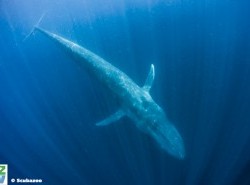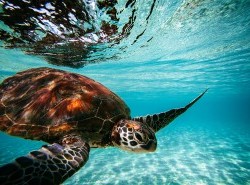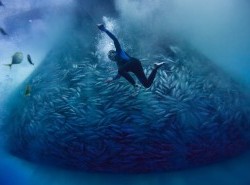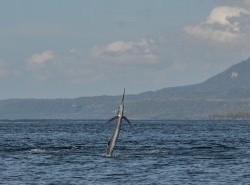The rain struck my skin like a thousand acupuncture needles, driven by a wind that almost bore my weight as I leant into it. The only real shelter on board the Balatik was the wheelhouse and 15 or so bedraggled guests huddled around Toto the tiller man as he squinted into the squall. But four or five of us preferred to stay outside with the crew as they hurried to lower the sails, everyone shouting and roaring with laughter at the fury of the elements. For the crew this was nothing of course – the Philippines is a magnet for some of the fiercest tropical storms on the planet. This was just a bracing prelude to rainy season.
Rainstorms can swell and recede with incredible speed
Still, hampered by the low visibility and unable to hear the shouted warnings from the bow, Toto ploughed into the rope floats bordering a pearl farm and we had to carefully reverse, while one of the crew dove under the keel to disentangle us. I made my way to the stern to check on the pig that had been brought on board earlier that morning. It looked surprisingly unfazed. Or resigned to its fate perhaps, since it was destined for the spit that night.
Captain Jener prepares to take in the fore sail
We were four days into an island-hopping voyage in the Palawan Archipelago, our vessel a native Filipino outrigger known as a Paraw – at 74 feet, the largest of its kind in existence. 22 sunburnt, barefoot wannabe buccaneers of varying ages and nationalities exploring hidden reefs, kayaking past jungle clad limestone monoliths and sleeping in bamboo huts on deserted beaches. It was a way of experiencing the islands that felt refreshingly unfiltered.
One of the many spectacular limestone karsts that stud the waters around northern Palawan
Named after its main island, the Philippines westernmost province is also its largest and least inhabited and it’s being positioned as the country’s new tourism jewel. Its biogeography is distinct from the rest of the Philippines, sharing many species of flora and fauna with Borneo and its 1700 odd islands feature dramatic limestone karsts, powdery white sand beaches and swathes of tropical rainforest. Last year, readers of Conde Nast Traveller voted Palawan the World’s Best Island and developers are queuing up to grab beachfront plots.
One of the beach cabanas at the Tao Organic Farm. The perfect digs for a night in the tropics!
But I’d forsaken landlubber luxuries in favour of boats – first this leisurely expedition between El Nido at the northern tip of Palawan and Coron on Busuanga Island off the north coast, where most travellers head after arriving in the capital, Puerto Princesa, four hours drive to the south. Then a week’s diving with a live aboard in Tubbataha, an isolated marine park out in the Sulu Sea that’s earning accolades not just for the diving, which is world class, but as a model of sustainable marine management.
Daily catch, which will later turn up on the buffet table
In fact both segments of the trip boasted impressive eco tourism credentials. Tao Philippines, which part owns the Paraw along with 10 other boats, has been running voyages like this for a decade and has built 16 camps scattered through the islands of north Palawan in partnership with the local communities here. Founders Jack Foottit and Eddie Brock Agamos started out with just one boat and a simple desire to explore the region. “We began bringing backpackers along because we hadn’t realised how much it costs to run a boat!” Eddie told me after my trip. “It grew organically from there and pretty soon we had the communities working with us and we were able to help them out with infrastructure, building schools, providing access to water. We’ve been able to build an economy, an entire ecosystem really around Tao. But we never had investors or a business plan, it just unfolded very naturally.” These days Tao is held up as model of how ecotourism enterprises can work and both Jack and Eddie give lectures all over the world.
A little boy shows his excitement as the Balatik anchors offshore
The Tao Organic Farm is by far the largest and best equipped of Tao’s camps, with ocean facing bamboo pavilions strewn along the beachfront for guests, an impressive permaculture enterprise, livestock, and a giant bamboo edifice that serves as a community centre for various cooperatives. It was here that I met Melot a grizzled old salt who’d lost an arm dynamite fishing some years before. In fact his whole life had been one of hardship, as he recounted one evening outside his home, a beach hut cluttered with nets and buoys and driftwood, while the youngest of his seven kids clambered over him. Recruited by communist rebels as a child and taught to shoot a gun, his father sent him off to join a crew of compressor divers – arguably an equally dangerous pursuit. Breathing air pumped through a simple plastic hose, scores of divers descend up to 40 metres with vast nets, which they manoeuvre over shoals. Many of Melot’s friends died – either from the bends, or by getting tangled in the nets. He said he took up dynamite fishing to feed his growing family.
The food at the Tao Organic Farm is all locally sourced, delicious...and of course, organic!
“Life’s much better now,” he told me. “I look after the water and electricity here, my wife runs the massage cooperative and my daughter’s going to college in Puerto Princesa,” he adds proudly. That’s thanks to Tao’s scholarship fund, which supports promising young students from the local villages. Palawan’s relative remoteness meant that it was sparsely populated until the seventies – though human remains have been found here dating as far back as 10,000 years. In the seventies, migrants started arriving from other parts of the Visayas Islands, which form the central part of the Philippines between Luzon in the north and Mindanao in the south. Today, like everywhere else in the country, fish stocks are under pressure thanks to a spiralling population and destructive fishing methods. Families who’ve fished for generations have been forced to turn to farming, resorting to slash and burn techniques in the absence of agricultural know how.
The Balatik under full sail
Tao has been gradually introducing permaculture techniques that are more sustainable. “We grow a wide variety of native vegetables, fruits and herbs, and we keep livestock,” Eddy told me. “Everything is locally available and integrated so there’s no waste. Now we’re setting up a marketplace with local farmers where we buy excess crops for our trips.”
The crew choose where we'll spend the night almost on the spur of the moment...none of the islands disappoint
It all seems to be paying off – the food offerings both at the farm and during our voyage were excellent. Our first stop was Kadlao Island where we waded onto a white beach in the lea of an enormous limestone crag. Jeff our jocular and tireless chef, cooked up a delicious mung bean stew served with giant trevally while the ship’s dog Datu, a solemn Jack Russell puppy, dug for crabs. We ate out under the stars as we did every evening. The next morning, there was an impromptu game of beach volleyball for those of us not nursing hangovers from the lethal rum cocktails, served from sunset each day. And then after a refreshing cold shower, a breakfast of watermelon slices and eggs with banana flour fritters loaded with onion and green pepper.
The Balatik is a beautiful, elegant vessel - the nets at the bow make great hammocks, with nothing but the waves beneath you
There’s no set schedule on board the Balatik – but expect to do a lot of snorkelling. Palawan is in the Coral Triangle, a million square kilometre bioregion that’s home to more marine species than anywhere else on the planet. The reefs were mesmerising; colourful subaquatic gardens teeming with tropical fish and occasionally larger pelagic species including turtles and trevally. On one of my last dives, the day after the rainstorm, I felt something nipping my chest and looked down to see a remora that must have mistaken me for a shark. It stuck around for the rest of the dive, nibbling at my skin, once quite painfully on my lip.
A little girl at sunset
I’d sometimes join the captain Jener up at the bow, where we’d sit wearing headphones, beer in hand, gazing at the blue on blue horizon, broken by the occasional palm studded atoll. As we neared Coron and the end of the voyage, he told me he’d spent two years building the Balatik after stumbling across the design in a book. “The last of these boats stopped trading in the seventies,” he said. “But they’ve been around since before the Spanish – they were once used as warships – you’d have 100 warriors rowing on the outriggers.” Building it was a major undertaking since there were no master shipbuilders familiar with the design and Jener insisted on using traditional materials, employing local tribes to carve indigenous motifs into the wood. Over the course of just a few days, the Balatik had come to feel like home - disembarking into the relative bustle of Coron felt like leaving on old friend behind. Until the next time...
For more information on Tao Philippines or to book your trip on the Balatik, head over to www.taophilippines.com










